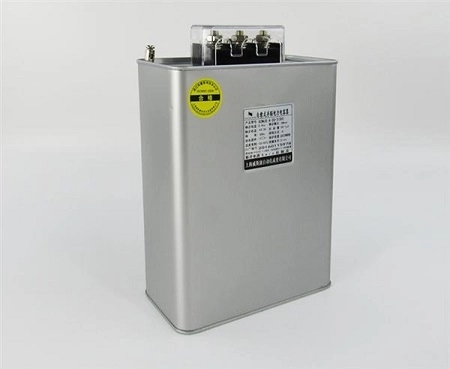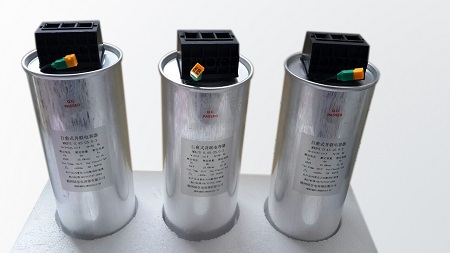What is a power capacitor?
1、 Classification of power capacitors
Power capacitors can be divided into 8 types based on their purpose:
① Parallel capacitors. Originally referred to as phase shifted capacitors. Mainly used to compensate for reactive power of induced loads in power systems, in order to improve power factor, improve voltage quality, and reduce line losses.
② Series capacitors. It is connected in series in power frequency high-voltage transmission and distribution lines to compensate for the distributed inductance of the line, improve the static and dynamic stability of the system, improve the voltage quality of the line, extend the transmission distance, and increase the transmission capacity.
③ Coupling capacitor. Mainly used for high-frequency communication, measurement, control, protection of high-voltage power lines, as well as as as components in energy extraction equipment
④ Circuit breaker capacitor. Formerly known as voltage balancing capacitors. The parallel connection on the break of an ultra-high voltage circuit breaker has the effect of balancing voltage, making the voltage between the breaks uniform during the breaking process, which can improve the arc extinguishing characteristics of the circuit breaker and increase the breaking capacity.
⑤ Electric thermal capacitors. It is used in electric heating equipment systems with frequencies ranging from 40 to 24000Hz to increase power factor and improve the voltage or frequency characteristics of the circuit.
⑥ Pulse capacitors. Mainly used for energy storage, as basic energy storage components such as impulse voltage generators, impulse current generators, circuit breaker test oscillation circuits, etc.
⑦ DC and filter capacitors. Used for high-voltage DC equipment and high-voltage rectifier filtering equipment.
⑧ Standard capacitors. Used as a standard capacitor or as a capacitive voltage divider device for measuring high voltage in power frequency high voltage dielectric loss circuits.

Power capacitor
In the power system, it is divided into high-voltage power capacitors (above 6KV) and low-voltage power capacitors
Low voltage power capacitors are divided into oil-immersed paper capacitors and self-healing power capacitors according to their property. According to their functions, they are divided into ordinary power capacitors and intelligent power capacitors.

Self-healing parallel capacitor
Taking Swell products from the United States as an example, this article introduces intelligent power capacitors.
Intelligent power capacitors integrate advanced technologies such as modern measurement and control, power electronics, network communication, automation control, and power capacitors. It changes the backward controller technology of traditional reactive power compensation device and the backward mechanical contactor or electromechanical integrated switch as the switching technology of switched capacitor. It also changes the cumbersome structure of traditional reactive power compensation devices, making the new generation of low-voltage reactive power compensation equipment have better compensation effects, smaller volume, lower power consumption, lower price, more flexible use, and more maintenance. Its convenience and long service life meet the higher requirements of modern power grids for reactive power compensation.
2、 Application field
The main application areas include:
Factory power distribution system
Residential distribution system
Municipal commercial buildings
Transportation tunnel power distribution system
Transformer box, whole cabinet, outdoor distribution box
3、 Causes of damage
In recent years, more and more power capacitors have been put into operation, but due to technical reasons such as poor management, power capacitors often suffer from damage and explosions. The reasons are as follows:
Internal component failure of capacitors: mainly caused by poor manufacturing process.
Insulation damage of capacitors to the casing: The high-voltage side leads of capacitors are made of thin copper. If the manufacturing process is poor, the edges are uneven, there are burrs or severe bending, and the tip is prone to corona. Corona will decompose the oil, causing the oil tank shell to expand, causing the oil level to decrease, leading to malfunctions. In addition, when the cover is sealed, if the welding time at the corners is too long, the internal insulation will be burned and oil and gas will be generated, which will greatly reduce the voltage and cause damage to the capacitor.
Poor sealing and oil leakage: Due to poor sealing of the assembly sleeve, moisture enters the interior, reducing the insulation resistance; Or due to oil leakage, the oil level may decrease, leading to pole to shell discharge or component breakdown.
Expansion and internal dissociation: Due to internal corona, breakdown discharge, and internal dissociation, the capacitor
Expansion and internal dissociation: Due to internal corona, breakdown discharge, and internal dissociation, the capacitor will reduce the initial dissociation voltage of the component below the working electric field strength under the action of overvoltage, resulting in physical, chemical, and electrical effects. Accelerate the aging and decomposition of insulation, generate gas, form a vicious cycle, increase the pressure on the casing of the box, cause the outer wall of the box to expand and cause an explosion.
Capacitor explosion caused by charging and closing: Any capacitor bank with rated voltage must not be charged and closed. Every time the capacitor bank is re closed, the capacitor must discharge for 3 minutes when the switch is disconnected. Otherwise, it may explode due to the remaining charge on the capacitor during closure. For this reason, it is usually stipulated that capacitor banks with a capacity exceeding 160 kV should be equipped with automatic discharge devices when there is no voltage, and it is also stipulated that the switches of capacitor banks are not allowed to be equipped with automatic closing devices.
In addition, capacitors may be damaged and exploded due to excessive temperature, poor ventilation, high operating voltage, large harmonic components, or operating overvoltage.
4、 Precautions
When installing capacitors, it is best to connect the wiring of each capacitor to the bus using a separate flexible cable. Do not use a hard busbar connection to prevent assembly stress from damaging the capacitor casing, damaging the seal, and causing oil leakage.
Any poor contact in the capacitor circuit can lead to high-frequency oscillating arcs, which will increase the working electric field strength of the capacitor and generate heat. Therefore, it is necessary to maintain good contact between the circuit and the grounding part during the installation process.
When capacitors of lower voltage levels are connected in series and operated in a network of higher voltage levels, measures such as installing insulators equivalent to the working voltage level should be taken to ensure reliable insulation between the shell of each unit and the ground.
After connecting the capacitors into a star shape, they are used for higher rated voltage without grounding the neutral point. The shell of the capacitor should be insulated from the ground.
Before installing the capacitor, a capacitor should be allocated once to balance the phase, and the deviation should not exceed 5% of the total capacity. When installing relay protection devices, the requirement that the balance current error during operation does not exceed the working current of the relay protection should also be met.
6. Separate compensation capacitor wiring should be carried out: for induction motors that are started directly or through a rheostat, the power factor increasing capacitor can be directly connected to the motor's outlet terminal, and no switchgear or fuses should be installed between the two; For induction motors starting with a star delta starter, it is best to use three single-phase capacitors, each directly connected in parallel to the two terminals of each phase winding, so that the connection of the capacitors is always consistent with the connection of the winding.
The 7-group compensation low-voltage capacitor should be connected to the outside of the low-voltage group bus power switch to prevent self-excitation when the group bus switch is disconnected.
The low-voltage capacitor bank used for centralized compensation should be specially equipped with switches and installed on the outside of the main switch, rather than on the low-voltage bus.
5、 Power capacitor production enterprise
In recent years, the main trend in the development of the electromechanical industry has been towards large-scale collectivization, merging related majors, and forming multinational corporations. The power container industry is no exception. The scale of the main production enterprises and their main products are introduced as follows:
1 ABB
ABB has capacitor production plants in 11 countries, including Sweden, the United Kingdom, Australia, Spain, Belgium, Canada, India, andThailand, with Sweden's power capacitor factory as its core. The total annual output of each factory is over 20 million kilowatt hours. In December 2000, a joint venture was established with Xi'an Power Capacitor Factory to establish Xi'an ABB Power Capacitor Co., Ltd. with an annual production capacity of 3.5 million kvar. Its main products include 1-25kV and 100-1000kvar parallel capacitors; 1~500kV, 0.6~3000MVA parallel device group; 3~300kV, 1~300MVA filtering units, SVC, DC transmission series compensation devices, filtering capacitors, unit devices, etc.
2 Cooper, USA
In May 1985, the initial merger between Megaraw Edison and Cooper resulted in an annual production of approximately 19 million kilowatt hours. According to American standards, the design field strength in the dielectric of capacitors can vary from low to high, with a maximum of 70/80kV/mm, usually without internal fuses. The characteristics of this product are: small size, light weight, and good characteristics. The main products include high and low voltage parallel capacitors and complete sets of devices, filter capacitors and complete sets of devices, etc.
3-day Qing Corporation
Its capacitor production accounts for 95% of Japan's total production, approximately 8 million kilowatt hours. The Kyoto headquarters mainly produces high-capacity box type parallel capacitors. In 1988, a branch was established in Thailand and a division factory was established in Taiwan Province, China. In the late 1990s, Wuxi Power Capacitor Factory established a joint venture company, mainly producing capacitive voltage transformers with good economic benefits. In recent years, it has also established a joint venture with the Wuxi factory to produce parallel capacitors and complete equipment.
4 Nokia Capacitor Company in Finland
Established in 1957, merged with Nokia in 1967, founded Nokia Capacitor Company in 1990, and became a member of SEHNIDER Group in 1994. Since 2000, it has been an independent global supplier. Headquartered in Tampere, Finland, 85% of our products are exported and our marketing network covers over 50 countries. Adopting European standards. The main products include: high and low voltage shunt capacitors and complete sets of devices, thyristor switched capacitor banks (TSC), automatic switching non tuning filter banks, shunt reactors, static compensation devices (SVC), series compensation devices (SC/ASC) non source filtering devices, etc...
5 General Electric Company of the United States
General Electric in the United States mainly produces high-voltage parallel capacitors and large capacity electric heating capacitors, as well as filters, pulse, DC capacitors, and complete sets of capacitors. According to American standards, the annual production is approximately 12 million kilowatt hours.
6 Alstom Sanan factory in France
According to European standards, parallel capacitors are equipped with discharge resistors, while single parallel capacitors above 150kvar are equipped with internal fuses. The annual output is approximately 3.5 million kilowatt hours.
-
Whatsapp

